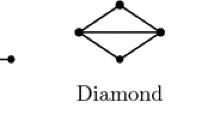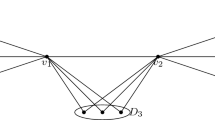Abstract
A strong clique in a graph is a clique intersecting all inclusion-maximal stable sets. Strong cliques play an important role in the study of perfect graphs. We study strong cliques in the class of diamond-free graphs, from both structural and algorithmic points of view. We show that the following five NP-hard or co-NP-hard problems remain intractable when restricted to the class of diamond-free graphs: Is a given clique strong? Does the graph have a strong clique? Is every vertex contained in a strong clique? Given a partition of the vertex set into cliques, is every clique in the partition strong? Can the vertex set be partitioned into strong cliques?
On the positive side, we show that the following two problems whose computational complexity is open in general can be solved in linear time in the class of diamond-free graphs: Is every maximal clique strong? Is every edge contained in a strong clique? These results are derived from a characterization of diamond-free graphs in which every maximal clique is strong, which also implies an improved Erdős-Hajnal property for such graphs.
Access this chapter
Tax calculation will be finalised at checkout
Purchases are for personal use only
Similar content being viewed by others
Notes
- 1.
In [25], the authors state that the two problems are NP-hard, but their proof actually shows co-NP-hardness.
References
Alcón, L., Gutierrez, M., Kovács, I., Milanič, M., Rizzi, R.: Strong cliques and equistability of EPT graphs. Discret. Appl. Math. 203, 13–25 (2016)
Alcón, L., Gutierrez, M., Milanič, M.: A characterization of claw-free CIS graphs and new results on the order of CIS graphs. Electron. Notes Theoret. Comput. Sci. 346, 15–27 (2019)
Alekseev, V.E.: On the number of maximal independent sets in graphs from hereditary classes. In: Combinatorial-Algebraic Methods in Discrete Optimization, pp. 5–8. University of Nizhny Novgorod (1991). (in Russian)
Andrade, D.V., Boros, E., Gurvich, V.: Not complementary connected and not CIS \(d\)-graphs form weakly monotone families. Discret. Math. 310(5), 1089–1096 (2010)
Andrade, D.V., Boros, E., Gurvich, V.: On graphs whose maximal cliques and stable sets intersect. In: Goldengorin, B. (ed.) Optimization Problems in Graph Theory. SOIA, vol. 139, pp. 3–63. Springer, Cham (2018). https://doi.org/10.1007/978-3-319-94830-0_2
Balas, E., Yu, C.S.: On graphs with polynomially solvable maximum-weight clique problem. Networks 19(2), 247–253 (1989)
Berge, C., Chvátal, V. (eds.): Topics on Perfect Graphs. North-Holland Mathematics Studies, vol. 88. North-Holland Publishing Co., Amsterdam (1984)
Berge, C., Duchet, P.: Strongly perfect graphs. In: Topics on Perfect Graphs. North-Holland Mathematics Studies, vol. 88, pp. 57–61. North-Holland, Amsterdam (1984)
Boros, E., Gurvich, V., Milanič, M.: On CIS circulants. Discrete Math. 318, 78–95 (2014)
Boros, E., Gurvich, V., Milanič, M.: On equistable, split, CIS, and related classes of graphs. Discret. Appl. Math. 216(part 1), 47–66 (2017)
Brandstädt, A., Giakoumakis, V., Maffray, F.: Clique separator decomposition of hole-free and diamond-free graphs and algorithmic consequences. Discret. Appl. Math. 160(4–5), 471–478 (2012)
Cheston, G.A., Hare, E.O., Hedetniemi, S.T., Laskar, R.C.: Simplicial graphs. In: 1988 19th Southeastern Conference on Combinatorics, Graph Theory, and Computing, Baton Rouge, LA, vol. 67, pp. 105–113 (1988)
Cheston, G.A., Jap, T.S.: A survey of the algorithmic properties of simplicial, upper bound and middle graphs. J. Graph Algorithms Appl. 10(2), 159–190 (2006)
Chudnovsky, M.: The Erdös-Hajnal conjecture-a survey. J. Graph Theor. 75(2), 178–190 (2014)
Chudnovsky, M., Goedgebeur, J., Schaudt, O., Zhong, M.: Obstructions for three-coloring graphs without induced paths on six vertices. J. Combin. Theory Ser. B 140, 45–83 (2020)
Chvátal, V., Slater, P.J.: A note on well-covered graphs. In: Quo Vadis, Graph Theory? Annals of Discrete Mathematics, vol. 55, pp. 179–181. North-Holland, Amsterdam (1993)
Dabrowski, K.K., Dross, F., Paulusma, D.: Colouring diamond-free graphs. J. Comput. Syst. Sci. 89, 410–431 (2017)
Deng, X., Li, G., Zang, W.: Proof of Chvátal’s conjecture on maximal stable sets and maximal cliques in graphs. J. Combin. Theor. Ser. B 91(2), 301–325 (2004)
Dobson, E., Hujdurović, A., Milanič, M., Verret, G.: Vertex-transitive CIS graphs. Eur. J. Combin. 44(part A), 87–98 (2015)
Erdős, P., Hajnal, A.: Ramsey-type theorems. Discret. Appl. Math. 25(1–2), 37–52 (1989). Combinatorics and complexity (Chicago, IL, 1987)
Gurvich, V.: On exact blockers and anti-blockers, \(\Delta \)-conjecture, and related problems. Discret. Appl. Math. 159(5), 311–321 (2011)
Gyárfás, A.: Reflections on a problem of Erdős and Hajnal. In: Graham, R.L., Nesetril, J. (eds.) The Mathematics of Paul Erdős, II. Algorithms and Combinatorics, vol. 14, pp. 93–98. Springer, New York (1997). https://doi.org/10.1007/978-1-4614-7254-4_11
Hoàng, C.T.: Efficient algorithms for minimum weighted colouring of some classes of perfect graphs. Discret. Appl. Math. 55(2), 133–143 (1994)
Hujdurović, A., Milanič, M., Ries, B.: Graphs vertex-partitionable into strong cliques. Discret. Math. 341(5), 1392–1405 (2018)
Hujdurović, A., Milanič, M., Ries, B.: Detecting strong cliques. Discret. Math. 342(9), 2738–2750 (2019)
Kamiński, M., Lozin, V.: Coloring edges and vertices of graphs without short or long cycles. Contrib. Discret. Math. 2(1), 61–66 (2007)
Karthick, T., Mishra, S.: On the chromatic number of (\(P_6\), diamond)-free graphs. Graphs Combin. 34(4), 677–692 (2018)
Kloks, T., Lee, C.-M., Liu, J., Müller, H.: On the recognition of general partition graphs. In: Bodlaender, H.L. (ed.) WG 2003. LNCS, vol. 2880, pp. 273–283. Springer, Heidelberg (2003). https://doi.org/10.1007/978-3-540-39890-5_24
Kloks, T., Müller, H., Vušković, K.: Even-hole-free graphs that do not contain diamonds: a structure theorem and its consequences. J. Combin. Theor. Ser. B 99(5), 733–800 (2009)
McAvaney, K., Robertson, J., DeTemple, D.: A characterization and hereditary properties for partition graphs. Discret. Math. 113(1–3), 131–142 (1993)
Milanič, M., Trotignon, N.: Equistarable graphs and counterexamples to three conjectures on equistable graphs. J. Graph Theor. 84(4), 536–551 (2017)
Prisner, E.: Graphs with few cliques. In: Alavi, Y., Schwenk, A. (eds.) Graph Theory, Combinatorics, and Algorithms: Proceedings of 7th Quadrennial International Conference on the Theory and Applications of Graphs, Western Michigan University, pp. 945–956. Wiley, New York (1995)
Sankaranarayana, R.S., Stewart, L.K.: Complexity results for well-covered graphs. Networks 22(3), 247–262 (1992)
Skowrońska, M., Sysło, M.M.: An algorithm to recognize a middle graph. Discret. Appl. Math. 7(2), 201–208 (1984)
Tsukiyama, S., Ide, M., Ariyoshi, H., Shirakawa, I.: A new algorithm for generating all the maximal independent sets. SIAM J. Comput. 6(3), 505–517 (1977)
Tucker, A.: Coloring perfect \((K_4-e)\)-free graphs. J. Combin. Theor. Ser. B 42, 313–318 (1987)
Zang, W.: Generalizations of Grillet’s theorem on maximal stable sets and maximal cliques in graphs. Discret. Math. 143(1–3), 259–268 (1995)
Zverovich, I., Zverovich, I.: Bipartite bihypergraphs: a survey and new results. Discret. Math. 306(8–9), 801–811 (2006)
Acknowledgements
The authors are grateful to Ademir Hujdurović for helpful discussions and the anonymous reviewers for constructive remarks. The second named author has been supported by the European Union’s Horizon 2020 research and innovation programme under the Marie Sklodowska-Curie grant agreement No. 734922, by Mexico’s CONACYT scholarship 254379/438356, by Erasmus+ for practices (SMT) Action KA103 - Project 2017/2019, by MICINN from the Spanish Government under project PGC2018-095471-B-I00, and by AGAUR from the Catalan Government under project 2017SGR1087. The first and third named authors are supported in part by the Slovenian Research Agency (I0-0035, research programs P1-0285 and P1-0404, and research projects J1-9110, N1-0102, N1-0160). Part of this work was done while the third named author was visiting LAMSADE, University Paris-Dauphine; their support and hospitality is gratefully acknowledged.
Author information
Authors and Affiliations
Corresponding author
Editor information
Editors and Affiliations
Rights and permissions
Copyright information
© 2020 Springer Nature Switzerland AG
About this paper
Cite this paper
Chiarelli, N., Martínez-Barona, B., Milanič, M., Monnot, J., Muršič, P. (2020). Strong Cliques in Diamond-Free Graphs. In: Adler, I., Müller, H. (eds) Graph-Theoretic Concepts in Computer Science. WG 2020. Lecture Notes in Computer Science(), vol 12301. Springer, Cham. https://doi.org/10.1007/978-3-030-60440-0_21
Download citation
DOI: https://doi.org/10.1007/978-3-030-60440-0_21
Published:
Publisher Name: Springer, Cham
Print ISBN: 978-3-030-60439-4
Online ISBN: 978-3-030-60440-0
eBook Packages: Computer ScienceComputer Science (R0)




